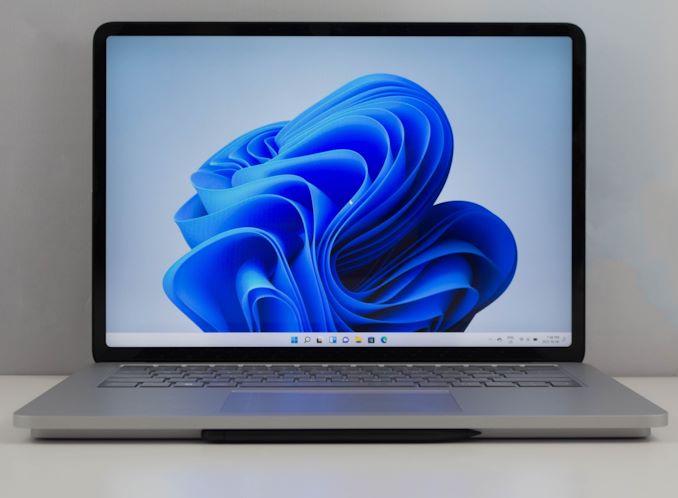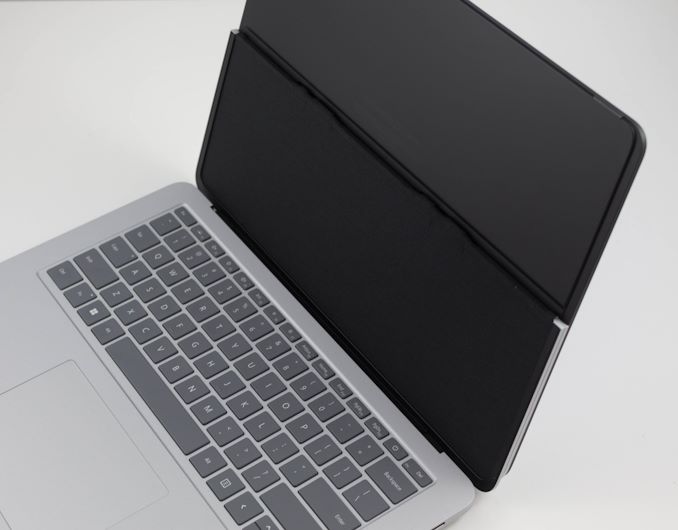The Microsoft Surface Laptop Studio Review: Dynamic Design
by Brett Howse on October 5, 2021 9:00 AM EST- Posted in
- Laptops
- Microsoft
- Surface
- Surface Laptop Studio
Final Words
As a self-professed fan of the Surface Book series of notebooks, it is a bit sad to see that device family depart. They were completely unique in the laptop world, with a style all their own. But there is no doubt that the Surface Book had some quirks and usability issues that created some user friction, and which Microsoft has aimed to solve with the Surface Laptop Studio.
The good news is that Microsoft has indeed delivered a worthy successor to the Surface Book. The new design with its dynamic woven hinge provides almost all of the same functionality as the Surface Book did without any of the clumsiness of having to detach the display to change modes. The Surface Laptop Studio allows you to seamlessly transition from Laptop to Stage to Studio mode, all with a single hand. The design also gets the benefit of the stability of a traditional clamshell laptop, with the weight on the bottom, and does so with barely any extra bulk from the display hinge itself. The display is only marginally thicker than a comparable notebook. It really is a great solution.
The rounded corners of the Laptop Studio, which flow into the display, are a great design touch as well. It is a bit sad to see the magnesium-alloy used on previous Surface devices be supplanted with aluminum, but Microsoft nailed the texture of the aluminum making it feel the same as the Surface Book. Despite being quicker than the Surface Book 3, it is also significantly smaller, and slightly lighter as well.
The new 14.4-inch PixelSense Flow display is wonderful to use. The 120 Hz refresh makes everything incredibly smooth, but thanks to the automatic refresh rate control, it can lower the refresh to save power when the faster response is not needed. It does lose a bit of pixel density compared to the outgoing Surface Book, but the added response time makes up for it. And, as usual, the display is incredibly accurate in its color reproduction.
The new keyboard and haptic touchpad also take the Laptop Studio to that next level. The key feel is superb, improving on the already great keyboards in previous Surface devices. The new trackpad is large, but not too large, and the adjustable haptic feedback works seamlessly.
Pen input is also well-executed with the new Surface Slim Pen 2, which can dock to the underside of the step, and charge right off the laptop. The Studio mode makes for a great writing surface and is a wonderful pairing with the pen support.
The Surface Laptop Studio has everything going for it. The design is striking. The functionality is fantastic. The performance is excellent. Even the battery life is superb. Can there even be a downside? Yes of course there is, and it is the price.
The Surface Book was a very expensive computer, so it should be no surprise that the replacement is also very expensive. Starting at $1599.99 USD for the Core i5 / 16 GB / 256 GB model and topping out at $3099.00 for a Core i7 / RTX / 32 GB / 2 TB model, the Surface Laptop Studio is most definitely expensive. Whether or not it is worth it is always a personal or business decision. Microsoft has delivered a worthy successor to the Surface Book which integrates wonderfully with Windows 11. Do you need it? Likely not. Do you want it? Likely yes.













53 Comments
View All Comments
cknobman - Tuesday, October 5, 2021 - link
I feel like Microsoft made a bad decision to go with the 3050ti.Nvidia hamstrung the 3050ti really bad with its memory capacity and bandwidth.
One of the few times I'd say save your money and stick with integrated graphics.
Manch - Tuesday, October 5, 2021 - link
Maybe a mid year refresh will have their in house discrete GPU's.I like the Surface book. This like all other foldables is a compromise. The book, disconnects and I have a nice thin tablet, connect, I have an excellent laptop with great battery, KB/TP and a DGPU. both of these are noticeably heavier than the previous kitted out Surface Book. Wish they'd keep selling the Book.
tipoo - Tuesday, October 5, 2021 - link
This isn't really a gaming system and the RTX stuff can help with some pro apps (such as OptiX), there's not really a comparable IGP yet.gescom - Tuesday, October 5, 2021 - link
I feel like Microsoft also made a bad decision to go with a 4 core Intel cpu.timecop1818 - Wednesday, October 6, 2021 - link
As opposed to what, 8 core piece of shit from AMD that doesn't have USB 4.0 or working IGPU?Prestissimo - Wednesday, October 6, 2021 - link
You know what's funny? "Acer ConceptD 3 Ezel 14" laptop is basically identical to this (because MS copied it), but the original Acer wisely used a 8-Core Intel + GTX 1650 and saved a few bucks on their low-end model.The Ezel 3 costs $1200 on eBay right now, VS the SLS that costs $2500 with a 2 year warranty, for almost identical specs.
Acer will refresh their whole Ezel lineup (5 laptops, goes up to i9/Xeon and 3080/Quadro A5000) in a few weeks, and for $2500 that Microsoft charges, you can buy the Acer Ezel 7 that will have an i7-11800H + 3060, and a much better Wacom EMR stylus.
cknobman - Wednesday, October 6, 2021 - link
Oh wow good catch!!Looking at the Acer it appears like Microsoft did copy their design.
edzieba - Friday, October 15, 2021 - link
That 'flip screen' form factor dates at least back to the 2013 Vaio Flip, and I'm pretty sure there was at least one Netbook (remember those?) that used that layout even earlier.Tams80 - Thursday, October 7, 2021 - link
It's a shame that the ConceptD 3 Ezel uses AES. The 7 is a bit too big, but Wacom EMR...Prestissimo - Saturday, October 9, 2021 - link
The device comes included with AES 1.0 but third party AES 2.0 pens do work on it, which is on par with the Surface Slim Pen 2's performance in terms of diagonal jitter and input lag.